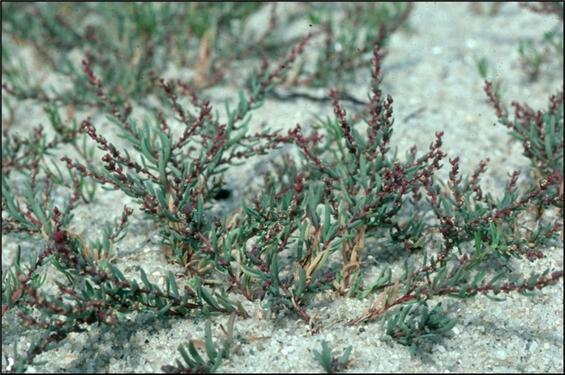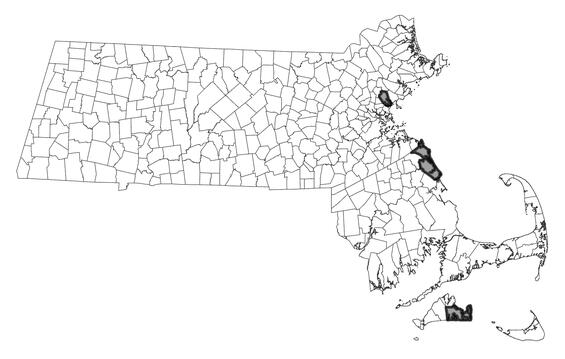- Scientific name: Suaeda calceoliformis (Hook.) Moq.
- Species of Greatest Conservation Need (MA State Wildlife Action Plan)
- Special Concern (MA Endangered Species Act)
Description

Image Credit: Bruce Sorrie
American sea-blite (Suaeda calceoliformis) is a widely branching annual member of the amaranth family (Amaranthaceae) found along the coast of Massachusetts. It is 20-30 cm (8-12 in) tall with fleshy, 2 cm (0.8 in) linear leaves, and low, spreading stems with more erect flowering tips. Tiny 2 mm (0.08 in) five-parted flowers are arranged in 5-10 cm (2-4 in) ascending spikes, and each is subtended by a 5-12 mm (0.2-0.5 in) leaf-like bract.
The succulent leaves of American sea-blite are plano-convex in cross-section, with a flat upper surface and a rounded lower side, giving the leaf a thick, fleshy feel. The lower parts of the stems are usually held almost horizontally, or even along the ground, while the outer stems and flowering spikes are ascending or erect. The green stems, leaves, and flowers may take on a red or purple tinge.
American sea-blite is found with saltmarsh sea-blite (S. maritima) and slender sea-blite (S. linearis). Saltmarsh sea-blite grows taller (up to 50 cm; 20 in) than American sea-blite, has longer leaves (3-5 cm; 1-2 in), and is green with a whitish waxy surface. Slender sea-blite is usually more erect than American sea-blite, and the leaves tend to be longer and darker green. American sea-blite is our only Suaeda that becomes reddish later in the season.
Life cycle and behavior
This is an annual species. American sea-blite is often found in monotypic patches. After flowering, the tiny seed is held by the folded-over sepals in a capsule-like structure. At least one of the five sepals is sharply pointed at the tip.

Population status
American sea-blite is listed under the Massachusetts Endangered Species Act as a species of special concern. All listed species are protected from killing, collecting, possessing, or sale, and from activities that would destroy habitat and thus directly or indirectly cause mortality or disrupt critical behaviors. American sea-blite is currently known from Plymouth, Barnstable, and Nantucket Counties and was also documented historically from Middlesex, Essex, Suffolk, Bristol, and Dukes Counties.
Distribution and abundance
American sea-blite occurs in saline soils throughout western North America and along the seacoast from Newfoundland to New Jersey. In New England, American Sea-blite is imperiled in Maine and Massachusetts, vulnerable in New Hampshire, not ranked in Connecticut or Rhode Island, and it isn't known to occur in Vermont.

Habitat
American sea-blite is found in a range of saline habitats in Massachusetts, including salt pond margins, the sandy border of salt marshes and estuaries, sandy and gravelly beaches, and tidal flats. Several Massachusetts records are from moist salt flats on the protected sides of low dunes. On marsh edges, American sea-blite grows below the zone of saltmarsh elder (Iva frutescens), and in a band between the Spartina-dominated marsh vegetation and the Ammophila-dominated dune vegetation. It is often found in monotypic patches on otherwise bare sand, or with saltmarsh sea-blite, slender sea-blite, seabeach orache (Atriplex cristata), prostrate orache (A. glabriuscula), sea-lavender (Limonium carolinianum), seabeach knotweed (Polygonum glaucum), and glasswort (Salicornia ambigua).
Healthy habitats are vital for supporting native wildlife and plants. Explore habitats and learn about conservation and restoration in Massachusetts.
Threats
Off-road vehicles and trampling from beach users are the primary threats at seashore locations; development is a threat at some estuarine locations.
Conservation
While this species is adapted to coastal conditions, shifting sand and storm damage present challenges and populations should be monitored to document long-term population trends. Sites should also be monitored for invasions of exotic plants and over-abundance of native plants; if exotic or native plants are out-competing American sea-blite, a plan should be developed, in consultation with Natural Heritage & Endangered Species Program, to remove the competitors. Known habitat locations should be protected from dramatic changes in light or moisture conditions. Rare plant locations that receive heavy recreational use should be carefully monitored for plant damage or soil disturbance, and trails should be re-routed as needed. All active management of rare plant populations (including invasive species removal) is subject to review under the Massachusetts Endangered Species Act and should be planned in close consultation with the Natural Heritage & Endangered Species Program.
References
Gleason, H A., and A. Cronquist. 1991. Manual of Vascular Plants of Northeastern United States and Adjacent Canada, 2nd edition. The New York Botanical Garden, Bronx, NY.
NatureServe. 2025. NatureServe Network Biodiversity Location Data accessed through NatureServe Explorer [web application]. NatureServe, Arlington, Virginia. Available https://explorer.natureserve.org/. Accessed: 6/3/2025.
USDA, NRCS. 2010. The PLANTS Database (http://plants.usda.gov). National Plant Data Center, Baton Rouge, LA 70874-4490 USA.
Contact
| Date published: | May 7, 2025 |
|---|